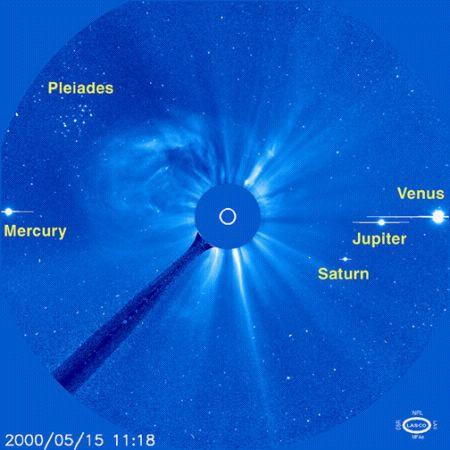Venus-Jupiter conjunctions like the one on May 17, 2000, are not terribly rare, notes John Mosley of the Griffith Observatory in an essay on Planetary Alignments in 2000. According to Mosley, the last time Venus and Jupiter were closer than on May 17, 2000 (separated by less than 42 arcseconds) was at 3:47 on July 21, 1859, when their centers were 32 arcseconds apart (there was no partial occultation). The next time will be at 12:45 on November 22, 2065, when their centers will be 16 arcseconds apart and the northern edge of Venus passes in front of Jupiter.
Although Venus and Jupiter will appear to be very close together on May 17, there's no danger of a collision. The two are really very far apart. Venus will be 257 million km from Earth, while Jupiter will be 896 million km away. The two are separated from each other by a comfortable 639 million km.
As Venus passes by Jupiter on May 17 the five classical planets (Mercury, Venus, Mars, Jupiter and Saturn) will span just 19° 25'. The cluster is too near the sun for naked-eye observations, but it's perfect for SOHO coronagraphs, which will be able to see all of the planets except Mars.
SOHO is a cooperative project between the European Space Agency (ESA) and NASA. The spacecraft was built in Europe for ESA and equipped with instruments by teams of scientists in Europe and the USA.
Space Weather News for May 16, 2000
On May 15 a coronagraph on the ESA/NASA Solar and Heliospheric Observatory captured rare images of a full halo coronal mass ejection with 4 planets and the Pleiades in the field of view. Material from the eruption could arrive in the neighborhood of Earth on May 17 or 18.
For more information and animations, visit SpaceWeather.com

ESA
May 15, 2000
Venus enhances SOHO's unique picture of planets beyond the Sun
Mercury, Venus, Jupiter, Saturn and the Sun all appear in the same image sent to Earth today (15 May) by the SOHO spacecraft. The picture with four planets is another scoop for SOHO.More at: http://sci.esa.int/content/news/index.cfm?aid=1&cid=1&oid=18970
NASA Science News for March 30, 2000
Next Thursday, April 6, three planets and the thin crescent Moon are going to put on a memorable sky show when the quartet converge inside a circle 9 degrees across. The grouping is just the prelude to a grander alignment of planets on May 5, 2000. Is doom at hand, as many mystics assert?
Find out by reading the FULL STORY at Planets for Dessert
Also, for kids and kids-at-heart, a younger person's version of this
article is available at the NASA Kids web site:
The
Planets Line Up
 Back to ASTRONET's home page
Back to ASTRONET's home page
 Terug naar ASTRONET's home page
Terug naar ASTRONET's home page